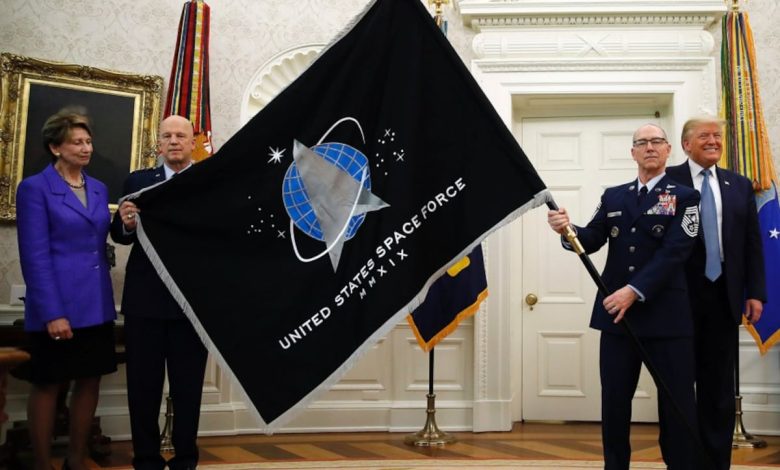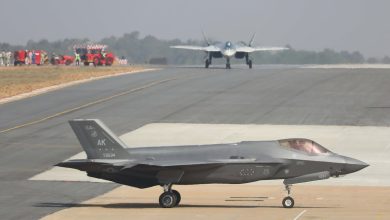Money, Musk and mission creep: How Trump could shape DOD’s space drift

When Congress authorized the creation of the Space Force in December of 2019, the service’s leadership viewed its small size as an asset.
Gen. Jay Raymond, its inaugural chief of space operations, likened the newest military branch to a startup company, telling lawmakers the service would leverage its size to move fast and stay nimble.
“We are establishing a Space Force that is lean, agile and mission-focused,” Raymond said in a March 2020 House Armed Services Committee hearing.
Since then, the service’s budget has doubled to around $30 billion in fiscal 2025, and today’s leaders have called for even more resources in the coming years to strengthen the military’s defenses against adversaries in space, build an arsenal of offensive-capable systems and take on new missions.
“That budget is going to need to double or triple over time to be able to fund the things we’re actually going to need to have,” Air Force Secretary Frank Kendall told Defense News last summer. “Somebody’s going to have to make some decisions about whether to give us a bigger budget overall for this or do some internal trades.”
The path to a larger Space Force budget isn’t clear — even as former President Donald Trump, who oversaw the creation of the service, prepares to begin his second term in the coming weeks. Despite his administration’s past emphasis on space policy, analysts and former defense officials told Defense News Trump’s enthusiasm for space doesn’t necessarily portend a larger budget for the Space Force.
Todd Harrison, a senior defense policy fellow at the American Enterprise Institute, said it’s unlikely Trump will get directly involved in the ins and outs of the Space Force’s budget.
“We know that Trump is obviously very supportive of the Space Force,” Harrison said in an interview. “When it comes down to actually proposing big increases in the Space Force’s budget, I’d say what matters more is the Secretary of Defense.”
Trump plans to nominate Pete Hegseth, a Fox News host and Army veteran, to lead the Pentagon. Harrison noted there’s no indication of Hegseth’s posture toward the Space Force — whether he’d be willing to go along with a larger space budget at the expense of another service.
“I think he’s walking into it with basically a clean slate,” Harrison said. “So, then I would think it would be up to the Space Force leadership to get in early and make their case.”
Trump has yet to reveal who he plans to nominate as Air Force secretary, or SECAF in Pentagon parlance, a role that provides civilian oversight of the Space Force’s budget. Were the president to choose a secretary with a space background, that could drive more investment, Harrison noted.
“That would be revolutionary,” he said. “If you had a SECAF that was very supportive of space, you could very well see them go forward with a [proposal] that significantly increases the Space Force’s budget, either using a higher overall topline or using offsetting cuts within the Air Force’s budget.”
Doug Loverro, a consultant who has held key space leadership roles in DOD, NASA and the National Reconnaissance Office, said regardless of who fills the leadership role, the Space Force will have to make a strong case to the new administration that it needs more funding.
That task, according to Loverro, will likely be an uphill battle. While the service has made plans for new architectures and has worked to speed up its acquisition programs through organizations like the Space Rapid Capabilities Office and the Space Development Agency, he said it hasn’t proven it can field operational capabilities on faster timelines.
“I think when the new administration comes in, they are going to look at that and they’re going to say, ‘What the heck have you been doing with all the money,’” Loverro said.
Strength in numbers
Loverro said he expects the incoming class of Pentagon leaders to put more of an emphasis on fielding new systems than on demonstrating concepts — an approach that features heavily in Project 2025, a 900-page conservative blueprint for the second Trump administration.
While the president-elect sought to distance itself from Project 2025 during his campaign, he has since acknowledged he supports some of its policy recommendations. The document includes a section on needed Space Force reforms that calls for the service to “end the current study phase of concept development and fielding of offensive systems.” It also specifically mentions the Space Development Agency, or SDA, recommending the organization adhere to more aggressive timelines for fielding satellites.
SDA is on a path to launching hundreds of spacecraft to support the Space Force’s missile tracking and data transport missions, but its first few launches are largely focused on demonstrating the capability and have been delayed by several months. The agency expects to have its first tranche of operational satellites in orbit by 2026.
“They want them to stop being experiments. They want them to be operational capability,” Loverro said.
Project 2025 also recommends the Space Force “restore architectural balance” between offensive and defensive capabilities, advocating for an approach to deterrence that includes protecting assets and fighting back against adversaries that threaten its systems.
That approach could drive more investment in so-called counterspace systems, most of which are funded through the Space Force’s roughly $6 billion classified budget. While the service has been talking more about the need for offensive weapons, much of its public-facing strategy for dealing with threats in space has centered on proliferated architectures like those SDA is launching.
The idea is, essentially, strength in numbers — having enough satellites in orbit that if an enemy destroys a few, the military can still perform its mission with the remaining spacecraft.
Sam Wilson, director of strategy and program support at the Aerospace Corporation’s Center for Space Policy and Strategy, said that while the first Trump administration supported proliferation as a method for deterrence, the next four years could expand on that approach. Whether that will include a more open discussion about fielding the types of space weapons China and Russia are demonstrating, or pursuing new operational approaches like sustained maneuver, is yet to be seen, he told Defense News.
“Based on the unclassified budget, the Space Force, to me, has largely thought about protecting its spacecraft using proliferation,” Wilson said. “But these other approaches could get attention to resources as well in the new administration.”
A strategy that centers on large fleets of small satellites could carry with it a hefty price tag, he added, especially if the Space Force continues to expand that approach beyond SDA’s missile tracking and data transport constellations to other mission areas like positioning, navigation and timing and space domain awareness.
“It’s expensive,” Wilson said. “We’ve seen it in several missions, and I think we may see it in more, but the degree to which that continues to be a point of emphasis is something to observe.”
Loverro said a greater focus on counterspace systems could come as soon as the fiscal 2026 budget request, which the White House traditionally releases in February or March but is often delayed during a presidential transition.
“It’s always in the conversation, but we haven’t really demonstrated that we’re fielding anything or that we intend to,” he said. “And we haven’t really talked about what’s the true intent of our counterspace ambitions.”
That shift could come with more funding attached, but Harrison noted that the Space Force can demonstrate its dominance in space without a larger budget. For example, he said, if Moscow continues jamming and spoofing GPS signals over Ukraine — as it has been doing since the start of the war — the U.S. could turn off GPS access over Russia.
“There are things you could do that would be fairly immediate that wouldn’t even cost anything, but it would show a lot more strength,” he said. “If Trump is trying to be buddy-buddy with Putin, maybe he wouldn’t do that. But if he wants to show strength when our space systems are being attacked, that would be one way of doing it.”
Favorite child?
At the White House, Trump has named Russell Vought as his pick to lead the Office of Management and Budget, a position he also held during Trump’s first administration.
OMB is responsible for coordinating a yearly federal budget proposal that reflects the president’s policy objectives. Given Trump’s likely interest in seeing the service he helped create succeed, that could bode will for the Space Force.
“I suspect you’re willing to spend more money on your child than you are to spend money on somebody else’s child,” Loverro said. “So, there will be a natural tendency for Trump to want to save the Space Force because it’s his child, or at least he perceives it as his child.”
However, because the president doesn’t typically get involved in the details of the budget process, Vought will likely be the gatekeeper for significant program increases.
Vought was a co-author of Project 2025 and is known for being a fiscal hawk. During the first Trump administration, Vought played a central role in budget fights between the president and Congress. His office helped devise a plan to pull billions of dollars from the defense budget to pay for the president’s plan to build a wall on the southern U.S. border.
Harrison said it’s not clear what stance OMB would take in a Space Force funding debate, but Vought’s reputation as a budget hardliner makes a major increase unlikely.
“I don’t think the prospects look good right now unless Trump is able to change the politics around the budget,” he said. “His OMB choice is very much a fiscal conservative wanting to cut government spending.”
Another area to watch for signs of Space Force budget growth is Congress.
A Republican majority in both the House and the Senate traditionally means a funding boost for defense initiatives. But current divisions in the party over defense spending could change that narrative.
On the Senate side, Armed Services Committee Chairman Roger Wicker, R-Miss., has called for a $55 billion increase in defense spending. In a 52-page paper outlining his proposal, he advocated for more funding to protect U.S. space systems and target China’s growing arsenal of space weapons.
“The U.S. Space Force has enjoyed real budgetary growth since its inception, but that does not mean it cannot do more. Classified programs in development must be procured at scale,” he said. “China’s over-the-horizon kill chains are all deeply reliant on space. Without these capabilities, the ‘bubble’ shrinks,” he added, referring to the notional radius in which Beijing operates its forward defenses.
In the House, the chances of a seeing larger defense budget in the near term are “not good,” Harrison said, especially as the House Freedom Caucus — a small group of budget hawks with outsize influence due to the Republican party’s narrow majority — proposes aggressive cuts to government spending.
“They are pushing for such a high level of spending cuts that there’s no way to get what they want without at least capping defense, if not cutting,” he said.
Loverro also predicted a “decreased stomach” for major budget increases, particularly the tripling proposed by Kendall.
“Obviously nobody’s going to take $60 billion away from the Navy or the Army to give it to the Space Force,” he said. “So, unless Congress is willing to raise the budget by $100 billion, I think the likelihood of seeing a large increase in the Space Force budget of the kind of numbers they’re talking about is extremely low.”
Trump’s wild card
While it’s unclear whether leaders within the Pentagon, Congress and the White House will support more funding for the Space Force, experts pointed out that Trump’s outward aversion to the status quo could uproot many of their assumptions about the next four years.
In fact, they noted, the Space Force’s establishment came amid major resistance within the Pentagon and with the support of small cadre of powerful advocates in the House Armed Services Committee, including Rep. Mike Rogers, R-Ala., and now-retired Rep. Jim Cooper, D-Tenn.
“All of those senior leaders had come out publicly said,’ No, this is a bad idea,’” Harrison said. “Trump came in separately after that . . . and said, ‘Yeah, we’re going to create it.’”
One known wild card in Trump’s second term is Elon Musk’s role as an advisor to the president-elect. The billionaire CEO of SpaceX and Tesla is set to co-lead a new government efficiency office and could influence the White House’s space policy priorities.
SpaceX has billions of dollars in government contracts with NASA and the Pentagon and is one of the top providers of military space launch services for the Space Force. The firm’s Starlink and Starshield communication satellites are also in high demand from commercial and government customers, including the military.
While Musk’s proximity to Trump could have implications for the Space Force’s budget, Harrison and Loverro suggested his influence is more likely to affect policies, particularly those that affect SpaceX.
Unless Musk goes to Trump with requests to increase funding for specific programs, Loverro noted, it’s unlikely he’ll drive decisions at that level.
“If [Trump] gets the bit in his mouth that he wants to get something done and somehow he’s convinced that we need to double the Space Force budget, that could happen,” he said. “But that kind of detail typically flows below him.”
Courtney Albon is C4ISRNET’s space and emerging technology reporter. She has covered the U.S. military since 2012, with a focus on the Air Force and Space Force. She has reported on some of the Defense Department’s most significant acquisition, budget and policy challenges.
Read the full article here






